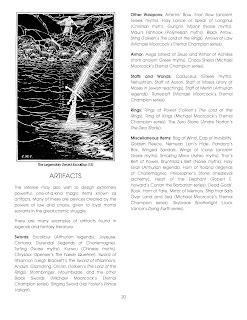As I covered in my previous post, I've been working on a retro-clone of the original 1974/1975 era Dungeons & Dragons rules titled The Fantasy Game. That post describes the first book, the Basic Player Guide, which covers rules for character creation, combat, magic, and exploration, which is roughly equal to Men & Magic, volume 1 of the three LBBs (little brown books) in the original boxed D&D set.
All work shown here is considered work-in-progress and is not final.
The Fantasy Game: Expert Referee Guides
My next two books in The Fantasy Game series are designed for the referee, transforming and re-editing the information found in Monsters & Treasure, volume 2 of the LBBs of OD&D.
Monster Menagerie
 |
| Expert Referee Guide: Monster Menagerie |
 |
| Monster Menagerie excerpt: Guide to Monsters |
I created a custom stat block for monster information that collects the important data found in disparate locations of the original rules, like the Monster Reference Table (Monsters & Treasure), the Character Alignment, Including Various Monsters & Creatures table (Men & Magic), extrapolated Morale quality values (Chainmail), and other information found in monster descriptions (Monsters & Treasure, Chainmail). The original game has scattered rules for certain "types" of monsters, such as undead, person, giant, and elemental, (especially with turning, charming, and controlling magics) so I explicitly specify if a monster fits a certain type in its stat block.
Now that I've posted the excerpt above, I've spotted a few spelling and formatting mistakes that I have already fixed.
 |
| Monster Menagerie excerpt: Griffon to Hobgoblin |
Yes, a hobgoblin is a "person" (as clarified in the description of the charm person spell in Men & Magic) and a griffon and a hippogriff are both considered to be "chimeras" (as per description of CHIMEREA (s.p.) in Chainmail).
Trove of Treasures
 |
| Expert Referee Guide: Trove of Treasures |
 |
| Trove of Treasures excerpt: first page of Magic Swords descriptions |
The majority of the book is dedicated to the descriptions of various magic items that may be found. The largest section details the rules for magic swords, which runs 3 1/2 pages. Magic swords in the original rules are incredibly powerful in comparison to any other editions. Every magic sword, even a lowly +1 broadsword, has an alignment with some level of intelligence and a chance to get into an ego conflict with its wielder. About half of all magic swords can communicate in some way with its wielder and has mental powers (such as detect magic or fly). Other miscellaneous types of magic weapons, even the mighty +3 war hammer, do not have these special attributes.
Magic swords truly seem to be the balancing factor of power between the original three classes. Clerics and magic-users learn to cast more powerful spells as they increase in levels, but fighting-men (or the later standardized "fighters") are the only ones who can wield the full power of magic swords. That is, until the thief class was first published in summer of 1974, ruled as being "able to employ magic swords and daggers" (Gary Gygax, The Thief Addition, 1974).
 |
| Trove of Treasures excerpt: Artifacts |
Later OD&D supplements (Eldritch Wizardry and Gods, Demi-gods, & Heroes) include rules for specific artifacts and relics that would become part of the D&D product identity or hail from literature and legend. The original LBB volumes briefly mention names for possible artifacts with no descriptions, such as teleportation machine and stone crystallization projector. In my version, I researched and collected a list of example artifacts found in legends and literature that have served or could serve as inspiration for items of powerful magic in a fantasy RPG campaign.
No comments:
Post a Comment